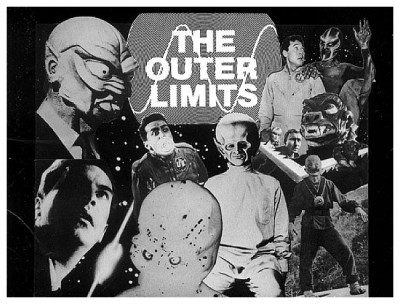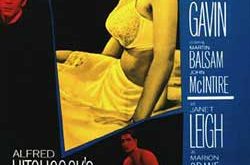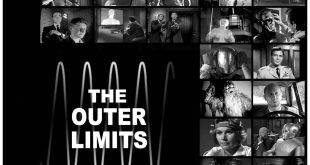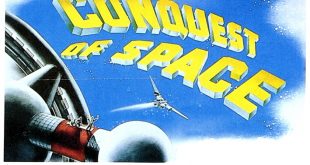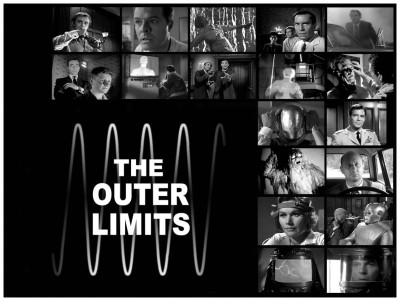 “There is nothing wrong with your television set. Do not attempt to adjust the picture. We are controlling transmission. We control the horizontal, we control the vertical. For the next hour, sit quietly and we will control what you see and hear. You are about to participate in a great adventure. You are about to experience the awe and mystery which reaches from the inner mind to…The Outer Limits.”
“There is nothing wrong with your television set. Do not attempt to adjust the picture. We are controlling transmission. We control the horizontal, we control the vertical. For the next hour, sit quietly and we will control what you see and hear. You are about to participate in a great adventure. You are about to experience the awe and mystery which reaches from the inner mind to…The Outer Limits.”
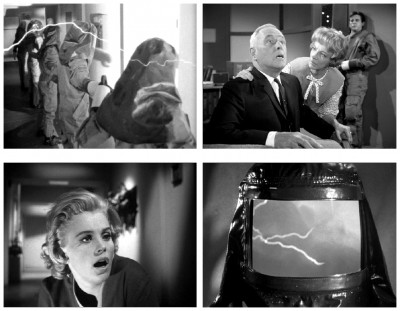 #30 PRODUCTION AND DECAY OF STRANGE PARTICLES written and directed by Leslie Stevens. While experimenting with subatomic particles, a team of physicists start a chain reaction that controls the researchers themselves. As one scientist after another is consumed and turned into nuclear ‘zombies’ by a form of sentient particles from another dimension, the reaction grows towards a terrible climax and the survivors fear they may be powerless to stop it. Just as the ever-expanding particles are about to engulf the lab and explode in an atomic cataclysm that could destroy the world, the head of the research facility calculates a formula to reverse the effects of the reaction incorporating a random element and succeeds in desensitising the new lifeform, rendering it powerless. This episode was made at a time when physicists were really starting to look beyond the Newtonian world and into the realm of subatomic particles and quantum theory. Scientists were beginning to confront the fact that the universe was far stranger than imagined, that there might be other realities beyond our own, so naturally the producers of The Outer Limits decided to speculate about what might happen if high-energy particle physicists cracked that doorway between such realities just a bit too wide. The script mentions many modern physics concepts such as neutrinos, antimatter, quasi-stellar objects and subatomic particles with the property of ‘strangeness’ (a quantum property of matter named by physicists, despite objections that it was no stranger than any other property of subatomic particles). The episode title is taken from a thesis published in 1956 called Cloud-Chamber Study Of The Production And Decay Of Strange Particles. I’m reminded of the nightmare scenarios concerning the Large Hadron Collider and how it might create a miniature black hole that would destroy the Earth. These fears are prefigured in this episode, and it’s the hard physics in the story that make it a refreshing change from the usual weird creatures and spaceships. Unfortunately the episode is severely hampered by melodrama, techno-babble, a slender plot and, worst of all, George Macready‘s overacting as the tormented Doctor Marshall. Keep an eye out (ow!) for Leonard Nimoy as Doctor Koenig.
#30 PRODUCTION AND DECAY OF STRANGE PARTICLES written and directed by Leslie Stevens. While experimenting with subatomic particles, a team of physicists start a chain reaction that controls the researchers themselves. As one scientist after another is consumed and turned into nuclear ‘zombies’ by a form of sentient particles from another dimension, the reaction grows towards a terrible climax and the survivors fear they may be powerless to stop it. Just as the ever-expanding particles are about to engulf the lab and explode in an atomic cataclysm that could destroy the world, the head of the research facility calculates a formula to reverse the effects of the reaction incorporating a random element and succeeds in desensitising the new lifeform, rendering it powerless. This episode was made at a time when physicists were really starting to look beyond the Newtonian world and into the realm of subatomic particles and quantum theory. Scientists were beginning to confront the fact that the universe was far stranger than imagined, that there might be other realities beyond our own, so naturally the producers of The Outer Limits decided to speculate about what might happen if high-energy particle physicists cracked that doorway between such realities just a bit too wide. The script mentions many modern physics concepts such as neutrinos, antimatter, quasi-stellar objects and subatomic particles with the property of ‘strangeness’ (a quantum property of matter named by physicists, despite objections that it was no stranger than any other property of subatomic particles). The episode title is taken from a thesis published in 1956 called Cloud-Chamber Study Of The Production And Decay Of Strange Particles. I’m reminded of the nightmare scenarios concerning the Large Hadron Collider and how it might create a miniature black hole that would destroy the Earth. These fears are prefigured in this episode, and it’s the hard physics in the story that make it a refreshing change from the usual weird creatures and spaceships. Unfortunately the episode is severely hampered by melodrama, techno-babble, a slender plot and, worst of all, George Macready‘s overacting as the tormented Doctor Marshall. Keep an eye out (ow!) for Leonard Nimoy as Doctor Koenig.
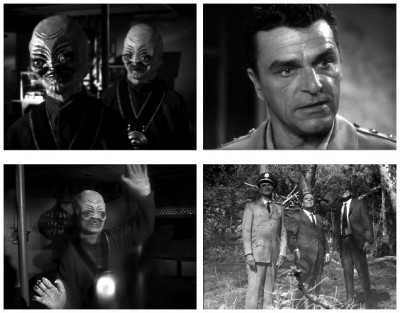 #31 THE CHAMELEON directed by Gerd Oswald from a script by Robert Towne, Lou Morheim and Joseph Stefano. An alien spacecraft lands in a remote part of the United States and wipes out a military patrol sent to investigate. Concerned that the ship may contain weapons of mass destruction, the authorities decide on a wild scheme: they recruit ex-CIA assassin Louis Mace (Robert Duvall) to infiltrate the ship. Mace can easily adapt to any personality required, and scientists genetically modify him to resemble the aliens. Giving up his body and life means little to Mace, who looks forward to testing his chameleon-like talents, but how much loyalty does Mace have for his fellow humans? Mace begins to question his allegiance, and eventually sides with the aliens, finding out that they are actually benevolent and have no desire to come in contact with humans in any way, being simply stranded on Earth after their ship’s engines had failed. Accepting Mace as one of their own, the aliens invite him to join them on their trip back to their home planet. Torn between his desire for freedom and his loyalty to his American superiors, Mace first reacts aggressively, killing one of the two aliens, but soon feels remorse for revealing the darker side of human nature. The remaining alien forgives Mace and allows him to leave Earth with him. Mace’s superior allows Mace to do so, believing this would be a chance for him to be free. Apart from some weird alien giggling, this is an excellent episode written by future Oscar-winner Robert Towne, quite original and well worth your time. It may be a little far-fetched but definitely interesting, particularly when you see what this agent does and how the aliens respond to him. Not a brilliant episode but certainly one that is strikingly original and a worthy addition to this excellent series.
#31 THE CHAMELEON directed by Gerd Oswald from a script by Robert Towne, Lou Morheim and Joseph Stefano. An alien spacecraft lands in a remote part of the United States and wipes out a military patrol sent to investigate. Concerned that the ship may contain weapons of mass destruction, the authorities decide on a wild scheme: they recruit ex-CIA assassin Louis Mace (Robert Duvall) to infiltrate the ship. Mace can easily adapt to any personality required, and scientists genetically modify him to resemble the aliens. Giving up his body and life means little to Mace, who looks forward to testing his chameleon-like talents, but how much loyalty does Mace have for his fellow humans? Mace begins to question his allegiance, and eventually sides with the aliens, finding out that they are actually benevolent and have no desire to come in contact with humans in any way, being simply stranded on Earth after their ship’s engines had failed. Accepting Mace as one of their own, the aliens invite him to join them on their trip back to their home planet. Torn between his desire for freedom and his loyalty to his American superiors, Mace first reacts aggressively, killing one of the two aliens, but soon feels remorse for revealing the darker side of human nature. The remaining alien forgives Mace and allows him to leave Earth with him. Mace’s superior allows Mace to do so, believing this would be a chance for him to be free. Apart from some weird alien giggling, this is an excellent episode written by future Oscar-winner Robert Towne, quite original and well worth your time. It may be a little far-fetched but definitely interesting, particularly when you see what this agent does and how the aliens respond to him. Not a brilliant episode but certainly one that is strikingly original and a worthy addition to this excellent series.
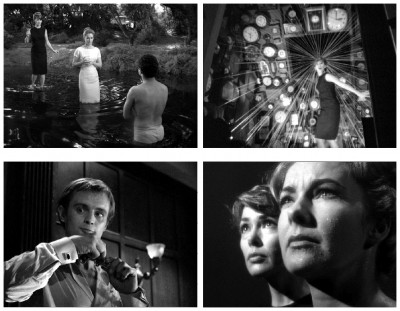 #32 THE FORMS OF THINGS UNKNOWN directed by Gerd Oswald from a script by Joseph Stefano. A car races through the countryside at high speed, driven by a wealthy playboy named Andre (Scott Marlowe), who is kissing his girlfriend Kassia (Vera Miles) while Kassia’s friend Leonora (Barbara Rush) sits in the back seat. Andre stops at a lake for a swim and strips down to his swimming trunks. He orders the women to make him a drink, and they do so – but lace the c**ktail with a leaf from the deadly Thanatos plant. Andre, with jovial cruelty, make the women serve his drink while he stands in the water. He drinks a toast to blackmailing Leonora’s father and dies immediately. The women put Andre’s corpse into the trunk of the car and drive off. Night soon falls and a thunderstorm starts as Kassia tries to calm Leonora, but then the trunk suddenly comes open. They stop the car to check on Andre, who hasn’t moved, but a lightning flash makes Leonora run away frightened. Kassia catches up and tries to calm her down, but both women are surprised by a shadow of a man standing nearby. Leonora freaks out again and runs to a nearby house. The door is answered by a blind man named Colas (Cedric Hardwicke) who lets them in. Colas explains that Mister Hobart (David McCallum) is not home, but will return soon. At last Hobart, an inventor, arrives to apologise to the women, explaining it was he they saw outside. He asks not to be disturbed as he goes upstairs to work on his invention. As he opens the door, we see Andre’s corpse attached to a strange device. Kassia decides to check on Andre, leaving Leonora alone. Hobart returns to ask Leonora what happened to Andre. She answers truthfully and he invites her upstairs to see Andre live again and be free of her guilt. He explains he’s invented a device that can ’tilt’ the past into the present and resurrect the dead. Reluctantly, Leonora agrees to see the device, which is essentially a large collection of clocks connected by wires to a pole in the centre of the room. The ticking of the clocks proves too much for Leonora, who runs back downstairs and faints. Hobart is more interested in the fact that Andre is no longer there. When Leonora wakes up, Kassia has returned, and Hobart has gone outside to look for Andre. Colas explains that he is not Hobart’s servant but the owner of the house, and Hobart is his boarder. Colas explains further that Hobart had apparently died and, when his body was placed on the time-tilter, he returned to life. The women decide to leave but get no further than the front door when they see the car has backed up to the entrance, the trunk opens and Andre pops out holding his empty glass and cheerfully asks for a refill. Leonora freaks out again and runs upstairs as Colas goes outside to find Hobart. Hobart tells Colas that he has unleashed a monster and returns to the house to correct that mistake. Inside the house, Andre asks how he died and, when Kassia tells him they used a leaf from the Thanatos plant, he replies, “That would do it.” Hobart returns downstairs with a pistol, intending to force Andre to return to the time-tilter. Andre is amused by this, disarms him, fires a shot above Hobart’s head then tosses the pistol aside, and drives off in the car. He doesn’t get far though – he crashes almost immediately and dies again. Hobart understands he has failed and goes upstairs. The women follow Hobart to his room, to see him step into his time-tilter and vanish. This is not only my favourite episode of The Outer Limits, it may actually be the finest hour of American television I’ve ever seen. The episode is an unusual one, even for this series. More than any other, it’s filled with weird camera angles, atmospheric photography, Gothic sets, creepy music, offbeat writing and strong performances, giving the episode a European ‘art-house’ feel. The story seems relatively simple, but not the way it’s told. It’s like some twisted otherworldly version of a William Shakespeare play – perhaps that’s what the producers were after. David McCallum is genuinely spooky and his facial expressions make him seem something not quite human. Crime melodrama? Science fiction? Art film? Poetry? All of the above. It’s a hell of a way for Joseph Stefano to quit the show – one can only wonder what might have been if he stayed, if he hadn’t pulled his own vanishing act, just as Hobart does in the final scene.
#32 THE FORMS OF THINGS UNKNOWN directed by Gerd Oswald from a script by Joseph Stefano. A car races through the countryside at high speed, driven by a wealthy playboy named Andre (Scott Marlowe), who is kissing his girlfriend Kassia (Vera Miles) while Kassia’s friend Leonora (Barbara Rush) sits in the back seat. Andre stops at a lake for a swim and strips down to his swimming trunks. He orders the women to make him a drink, and they do so – but lace the c**ktail with a leaf from the deadly Thanatos plant. Andre, with jovial cruelty, make the women serve his drink while he stands in the water. He drinks a toast to blackmailing Leonora’s father and dies immediately. The women put Andre’s corpse into the trunk of the car and drive off. Night soon falls and a thunderstorm starts as Kassia tries to calm Leonora, but then the trunk suddenly comes open. They stop the car to check on Andre, who hasn’t moved, but a lightning flash makes Leonora run away frightened. Kassia catches up and tries to calm her down, but both women are surprised by a shadow of a man standing nearby. Leonora freaks out again and runs to a nearby house. The door is answered by a blind man named Colas (Cedric Hardwicke) who lets them in. Colas explains that Mister Hobart (David McCallum) is not home, but will return soon. At last Hobart, an inventor, arrives to apologise to the women, explaining it was he they saw outside. He asks not to be disturbed as he goes upstairs to work on his invention. As he opens the door, we see Andre’s corpse attached to a strange device. Kassia decides to check on Andre, leaving Leonora alone. Hobart returns to ask Leonora what happened to Andre. She answers truthfully and he invites her upstairs to see Andre live again and be free of her guilt. He explains he’s invented a device that can ’tilt’ the past into the present and resurrect the dead. Reluctantly, Leonora agrees to see the device, which is essentially a large collection of clocks connected by wires to a pole in the centre of the room. The ticking of the clocks proves too much for Leonora, who runs back downstairs and faints. Hobart is more interested in the fact that Andre is no longer there. When Leonora wakes up, Kassia has returned, and Hobart has gone outside to look for Andre. Colas explains that he is not Hobart’s servant but the owner of the house, and Hobart is his boarder. Colas explains further that Hobart had apparently died and, when his body was placed on the time-tilter, he returned to life. The women decide to leave but get no further than the front door when they see the car has backed up to the entrance, the trunk opens and Andre pops out holding his empty glass and cheerfully asks for a refill. Leonora freaks out again and runs upstairs as Colas goes outside to find Hobart. Hobart tells Colas that he has unleashed a monster and returns to the house to correct that mistake. Inside the house, Andre asks how he died and, when Kassia tells him they used a leaf from the Thanatos plant, he replies, “That would do it.” Hobart returns downstairs with a pistol, intending to force Andre to return to the time-tilter. Andre is amused by this, disarms him, fires a shot above Hobart’s head then tosses the pistol aside, and drives off in the car. He doesn’t get far though – he crashes almost immediately and dies again. Hobart understands he has failed and goes upstairs. The women follow Hobart to his room, to see him step into his time-tilter and vanish. This is not only my favourite episode of The Outer Limits, it may actually be the finest hour of American television I’ve ever seen. The episode is an unusual one, even for this series. More than any other, it’s filled with weird camera angles, atmospheric photography, Gothic sets, creepy music, offbeat writing and strong performances, giving the episode a European ‘art-house’ feel. The story seems relatively simple, but not the way it’s told. It’s like some twisted otherworldly version of a William Shakespeare play – perhaps that’s what the producers were after. David McCallum is genuinely spooky and his facial expressions make him seem something not quite human. Crime melodrama? Science fiction? Art film? Poetry? All of the above. It’s a hell of a way for Joseph Stefano to quit the show – one can only wonder what might have been if he stayed, if he hadn’t pulled his own vanishing act, just as Hobart does in the final scene.
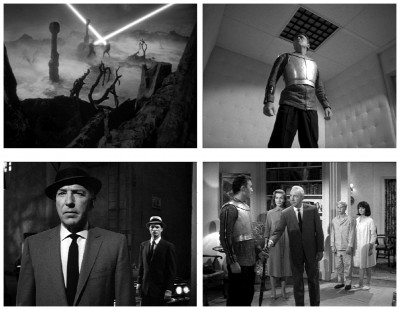 #33 SOLDIER directed by Gerd Oswald from a script by Harlan Ellison. Eighteen hundred years in the future, two foot soldiers clash on a battlefield. A random energy weapon strikes them both, and they are hurled into a time vortex. While one soldier is trapped in a time-eddy the other, Qarlo Clobregnny (Michael Ansara), materialises on a city street in the United States in the year 1964. Qarlo is soon captured and interrogated by a philologist named Tom Kagan (Lloyd Nolan) and his origin is eventually discovered. Qarlo has been trained for one purpose, to kill the enemy, and that’s all he knows. Progress is made in ‘taming’ him after Kagan translates his seemingly unintelligible language – “Nims qarlo clobregnny prite arem aean teaan deao” – into colloquial English – “Name is Qarlo Clobregnny. Private. R.M.E.N.T.N.D.O.” – his name, rank and serial number, which is what any soldier would reveal if captured by the enemy. After a short time in captivity, Qarlo is moved into the Kagan family house in an effort to further break through Qarlo’s tough exterior, and share knowledge of his way of life in the future. But the time-eddy holding the enemy soldier slowly weakens until he finally materialises, and tracks Qarlo to the Kagan home. In a final hand-to-hand battle, Qarlo sacrifices his life to kill the enemy and save the Kagan family.
#33 SOLDIER directed by Gerd Oswald from a script by Harlan Ellison. Eighteen hundred years in the future, two foot soldiers clash on a battlefield. A random energy weapon strikes them both, and they are hurled into a time vortex. While one soldier is trapped in a time-eddy the other, Qarlo Clobregnny (Michael Ansara), materialises on a city street in the United States in the year 1964. Qarlo is soon captured and interrogated by a philologist named Tom Kagan (Lloyd Nolan) and his origin is eventually discovered. Qarlo has been trained for one purpose, to kill the enemy, and that’s all he knows. Progress is made in ‘taming’ him after Kagan translates his seemingly unintelligible language – “Nims qarlo clobregnny prite arem aean teaan deao” – into colloquial English – “Name is Qarlo Clobregnny. Private. R.M.E.N.T.N.D.O.” – his name, rank and serial number, which is what any soldier would reveal if captured by the enemy. After a short time in captivity, Qarlo is moved into the Kagan family house in an effort to further break through Qarlo’s tough exterior, and share knowledge of his way of life in the future. But the time-eddy holding the enemy soldier slowly weakens until he finally materialises, and tracks Qarlo to the Kagan home. In a final hand-to-hand battle, Qarlo sacrifices his life to kill the enemy and save the Kagan family.
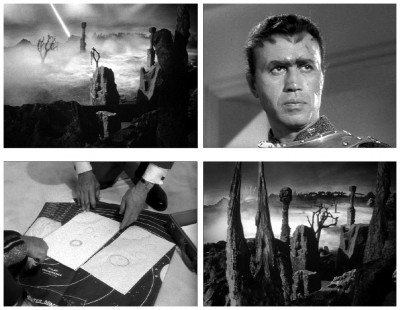 While the idea of a super-soldier being magically transported to the past is plain crazy, it’s still a great story because of the writing. You really care about the characters and Ansara and Nolan manage to do a lot with the script as well. Unusual, fascinating and well worth your time. Ellison also wrote Demon With A Glass Hand, and it’s real a shame he didn’t write more for this series. I assume this is because The Outer Limits ended soon after he wrote these two shows but it also might have had something to do with Ellison’s personality, as he is notorious for alienating himself from authority. Ellison brought suit against The Terminator (1984) distributor Orion Pictures for plagiarism of this episode. Despite James Cameron‘s insistence that the two stories had almost nothing to do with each other, Orion Pictures settled the lawsuit behind Cameron’s back for an undisclosed amount and an acknowledgement of Ellison’s works was added to the end credits of The Terminator. One last piece of trivia: Qarlo’s battle helmet would reappear on television years later in the situation comedy Happy Days worn by a visiting alien named Mork (Robin Williams).
While the idea of a super-soldier being magically transported to the past is plain crazy, it’s still a great story because of the writing. You really care about the characters and Ansara and Nolan manage to do a lot with the script as well. Unusual, fascinating and well worth your time. Ellison also wrote Demon With A Glass Hand, and it’s real a shame he didn’t write more for this series. I assume this is because The Outer Limits ended soon after he wrote these two shows but it also might have had something to do with Ellison’s personality, as he is notorious for alienating himself from authority. Ellison brought suit against The Terminator (1984) distributor Orion Pictures for plagiarism of this episode. Despite James Cameron‘s insistence that the two stories had almost nothing to do with each other, Orion Pictures settled the lawsuit behind Cameron’s back for an undisclosed amount and an acknowledgement of Ellison’s works was added to the end credits of The Terminator. One last piece of trivia: Qarlo’s battle helmet would reappear on television years later in the situation comedy Happy Days worn by a visiting alien named Mork (Robin Williams).
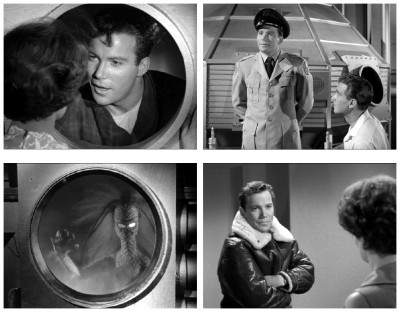 #34 COLD HANDS WARM HEART directed by Charles Haas from a script by Dan Ullman. After completing Project Vulcan – the first manned mission to orbit Venus – astronaut Jeff Barton (William Shatner) returns to Earth suffering recurring nightmares and an increasing inability to stay warm. Barton’s condition continues to worsen and is accompanied by a peculiar webbing between his fingers. Only after his nightmares become more vivid does he recall encountering an alien while traveling through the Venusian atmosphere. Barton’s doctors suspect the astronaut has been altered on a genetic level during his mission, and they struggle to cure him before his mutations completely take over. This story may well be the worst of The Outer Limits, but not because of William Shatner, who is charming as usual. Say what you will about his acting, his performance in Cold Hands Warm Heart is one of the few good things about this episode. The rest of the performances are reasonable enough, although Geraldine Brooks as the astronaut’s wife is rather irritating. The characters could have used more development, and the dialogue is varied at best. The real problem here is the tediously boring story, especially in its progression, the editing and cinematography is uninspired, and the effects are underwhelming to say the least: the Venusian always reminds me of the seventies television hand-puppet known as ‘Madame‘. For a potentially interesting science fiction concept, the episode is not compelling at all, and was done far better in the B-grade exploitation film The Incredible Melting Man (1977).
#34 COLD HANDS WARM HEART directed by Charles Haas from a script by Dan Ullman. After completing Project Vulcan – the first manned mission to orbit Venus – astronaut Jeff Barton (William Shatner) returns to Earth suffering recurring nightmares and an increasing inability to stay warm. Barton’s condition continues to worsen and is accompanied by a peculiar webbing between his fingers. Only after his nightmares become more vivid does he recall encountering an alien while traveling through the Venusian atmosphere. Barton’s doctors suspect the astronaut has been altered on a genetic level during his mission, and they struggle to cure him before his mutations completely take over. This story may well be the worst of The Outer Limits, but not because of William Shatner, who is charming as usual. Say what you will about his acting, his performance in Cold Hands Warm Heart is one of the few good things about this episode. The rest of the performances are reasonable enough, although Geraldine Brooks as the astronaut’s wife is rather irritating. The characters could have used more development, and the dialogue is varied at best. The real problem here is the tediously boring story, especially in its progression, the editing and cinematography is uninspired, and the effects are underwhelming to say the least: the Venusian always reminds me of the seventies television hand-puppet known as ‘Madame‘. For a potentially interesting science fiction concept, the episode is not compelling at all, and was done far better in the B-grade exploitation film The Incredible Melting Man (1977).
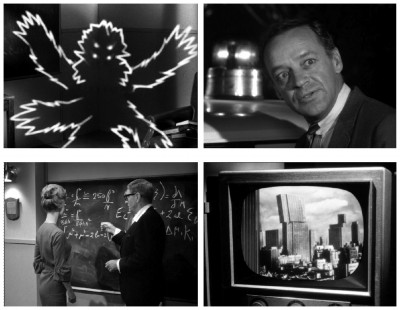 #35 BEHOLD ECK! directed by Byron Haskin from a script by John Mantley and William R. Cox. Doctor James Stone (Peter Lynd Hayes) is a brilliant optic engineer in a field that few people appreciate. His brother Bernard (Parley Baer) is a prominent physicist who refuses to take him seriously. James’ attractive secretary Elizabeth Dunn (Joan Freeman) is in love with him, but James is blind to her feelings. Policemen investigate the destruction of James Stone’s office, the latest in a series of attacks on optometrists. After they leave, James finds that his own spectacles are broken and instead tries on a pair of prescription glasses with lenses made from meteoric quartz designed for patients who suffer from double vision. Donning the spectacles, he recoils in horror as he sees a creature made of energy, which smashes his glasses, steals a list of patients who have been prescribed the lenses and quickly vanishes. James believes the creature exists in only two dimensions: it moves through walls and becomes invisible when turned to the side. James then orders several new pairs of the lenses and tracks down the patients on the list. One is injured, another one dead and the third, a welder, managed to ward off the creature with his welding torch. After a large building is found cut in half, The authorities also begin to investigate the occurrences. Meanwhile, James suddenly seems to notice his love-struck Miss Dunn for the first time, and begins to refer to his secretary by her first name Elizabeth as they become closer. The creature, named Eck, appears again to James and explains that it was transported to our dimensional plane by an experimental portal created by its species. Eck must return to his own dimension and close it, or else more things could fall through the rift. In order to find the rift, Eck requires special lenses to correct his two-dimensional vision, and gives James one of his eyes, explaining that a lens must be constructed within twenty-four hours as he is dying. James begins to grind the inter-dimensional lens while Eck watches a television news broadcast. Thinking the broadcaster is also two-dimensional, he jumps into the TV set, which causes Eck to become luminous. The now-visible Eck wreaks more havoc upon the city then returns with the police close behind. The authorities break into the office with a flamethrower and apparently kill Eck with fire. After they leave, James and Elizabeth find Eck still alive. James produces the inter-dimensional lens and offers to take it to the public square where the rift is located. Eck exits through the wall, James asks Elizabeth if she would like to go to the square to, “Say goodbye to a friend,” and the two exit as a couple. This is one of those Outer Limits episodes that viewers either seem to love or hate, and I find myself in the latter group. It’s a very weak story indeed, not to mention rather cheap-looking. The creature animation is downright amateurish, and most of the episode takes place in only two rooms, making it seem even lower-budget than most Outer Limits episodes. The idea of a two-dimensional world was first explored in the 1884 novella Flatland: A Romance Of Many Dimensions by Edwin Abbott. Screenwriter William Cox wove a lighthearted comedy treatment around the two-dimensional concept entitled The Reluctant Monster, which was rewritten by John Mantley, who went on to produce the television western Gunsmoke from 1965 to 1975.
#35 BEHOLD ECK! directed by Byron Haskin from a script by John Mantley and William R. Cox. Doctor James Stone (Peter Lynd Hayes) is a brilliant optic engineer in a field that few people appreciate. His brother Bernard (Parley Baer) is a prominent physicist who refuses to take him seriously. James’ attractive secretary Elizabeth Dunn (Joan Freeman) is in love with him, but James is blind to her feelings. Policemen investigate the destruction of James Stone’s office, the latest in a series of attacks on optometrists. After they leave, James finds that his own spectacles are broken and instead tries on a pair of prescription glasses with lenses made from meteoric quartz designed for patients who suffer from double vision. Donning the spectacles, he recoils in horror as he sees a creature made of energy, which smashes his glasses, steals a list of patients who have been prescribed the lenses and quickly vanishes. James believes the creature exists in only two dimensions: it moves through walls and becomes invisible when turned to the side. James then orders several new pairs of the lenses and tracks down the patients on the list. One is injured, another one dead and the third, a welder, managed to ward off the creature with his welding torch. After a large building is found cut in half, The authorities also begin to investigate the occurrences. Meanwhile, James suddenly seems to notice his love-struck Miss Dunn for the first time, and begins to refer to his secretary by her first name Elizabeth as they become closer. The creature, named Eck, appears again to James and explains that it was transported to our dimensional plane by an experimental portal created by its species. Eck must return to his own dimension and close it, or else more things could fall through the rift. In order to find the rift, Eck requires special lenses to correct his two-dimensional vision, and gives James one of his eyes, explaining that a lens must be constructed within twenty-four hours as he is dying. James begins to grind the inter-dimensional lens while Eck watches a television news broadcast. Thinking the broadcaster is also two-dimensional, he jumps into the TV set, which causes Eck to become luminous. The now-visible Eck wreaks more havoc upon the city then returns with the police close behind. The authorities break into the office with a flamethrower and apparently kill Eck with fire. After they leave, James and Elizabeth find Eck still alive. James produces the inter-dimensional lens and offers to take it to the public square where the rift is located. Eck exits through the wall, James asks Elizabeth if she would like to go to the square to, “Say goodbye to a friend,” and the two exit as a couple. This is one of those Outer Limits episodes that viewers either seem to love or hate, and I find myself in the latter group. It’s a very weak story indeed, not to mention rather cheap-looking. The creature animation is downright amateurish, and most of the episode takes place in only two rooms, making it seem even lower-budget than most Outer Limits episodes. The idea of a two-dimensional world was first explored in the 1884 novella Flatland: A Romance Of Many Dimensions by Edwin Abbott. Screenwriter William Cox wove a lighthearted comedy treatment around the two-dimensional concept entitled The Reluctant Monster, which was rewritten by John Mantley, who went on to produce the television western Gunsmoke from 1965 to 1975.
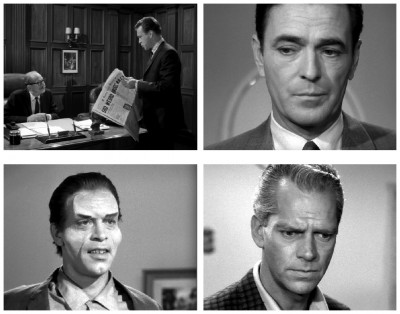 #36 EXPANDING HUMAN directed by Gerd Oswald from a script by Francis Cockrell. A mysterious figure prowls a university campus at night and rips the door off of a locked storage room to steal chemicals. A security guard spots the intruder but, before he can react, the thief kills the guard and carries the body away. Police investigator Lieutenant Branch (James Doohan) can’t figure out how the door was removed or the guard asphyxiated, and the stolen chemicals are rather mystifying as well, being consciousness-expanding drugs. The head of the experimental drug program Doctor Wayne (Keith Andes) and his associate Doctor Clinton (Skip Homeier) insist that there was nothing worth stealing, much less murder for, but the Lieutenant checks out a connection between the crimes and a group of students who were previously dismissed from the university for their consciousness-expanding experiments. Doctor Wayne is disturbed to discover that Doctor Clinton has been pursuing forbidden drug experiments with a group of graduate students. When one of the students turns up dead, Wayne himself investigates Clinton’s activities, and discovers that consciousness-expansion can have powerful and dangerous consequences. Trying to speed up man’s evolution, Clinton has been recklessly experimenting on himself, gaining super intelligence and new abilities, but at the cost of his morality and humanity.
#36 EXPANDING HUMAN directed by Gerd Oswald from a script by Francis Cockrell. A mysterious figure prowls a university campus at night and rips the door off of a locked storage room to steal chemicals. A security guard spots the intruder but, before he can react, the thief kills the guard and carries the body away. Police investigator Lieutenant Branch (James Doohan) can’t figure out how the door was removed or the guard asphyxiated, and the stolen chemicals are rather mystifying as well, being consciousness-expanding drugs. The head of the experimental drug program Doctor Wayne (Keith Andes) and his associate Doctor Clinton (Skip Homeier) insist that there was nothing worth stealing, much less murder for, but the Lieutenant checks out a connection between the crimes and a group of students who were previously dismissed from the university for their consciousness-expanding experiments. Doctor Wayne is disturbed to discover that Doctor Clinton has been pursuing forbidden drug experiments with a group of graduate students. When one of the students turns up dead, Wayne himself investigates Clinton’s activities, and discovers that consciousness-expansion can have powerful and dangerous consequences. Trying to speed up man’s evolution, Clinton has been recklessly experimenting on himself, gaining super intelligence and new abilities, but at the cost of his morality and humanity.
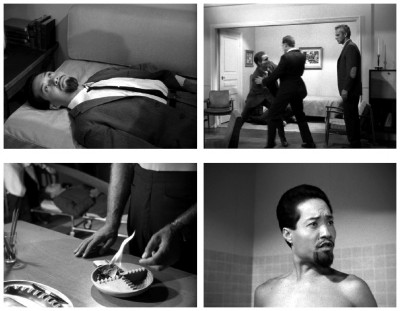 As usual, The Outer Limits was once again ahead of its time. Universities were heavily experimenting with LSD during the sixties resulting in amazingly positive and promising results until the Richard Nixon administration shut the whole thing down and released a lot of negative propaganda about the drug. This story poses many questions concerning the potential of consciousness-expansion in this eerie and suspenseful mystery. Some may consider the episode too talky and, if you’re looking for mind-blowing science fiction, this may not be for you. There are many obvious similarities to The Strange Case Of Doctor Jekyll And Mister Hyde by Robert Louis Stevenson, as well as the film Altered States (1980) by award-winning television writer Paddy Chayefsky, who was no doubt inspired by this story. It’s also worth noting that this episode is one of the few to show a person actually bleeding – normally deaths were quite bloodless on television during the sixties.
As usual, The Outer Limits was once again ahead of its time. Universities were heavily experimenting with LSD during the sixties resulting in amazingly positive and promising results until the Richard Nixon administration shut the whole thing down and released a lot of negative propaganda about the drug. This story poses many questions concerning the potential of consciousness-expansion in this eerie and suspenseful mystery. Some may consider the episode too talky and, if you’re looking for mind-blowing science fiction, this may not be for you. There are many obvious similarities to The Strange Case Of Doctor Jekyll And Mister Hyde by Robert Louis Stevenson, as well as the film Altered States (1980) by award-winning television writer Paddy Chayefsky, who was no doubt inspired by this story. It’s also worth noting that this episode is one of the few to show a person actually bleeding – normally deaths were quite bloodless on television during the sixties.
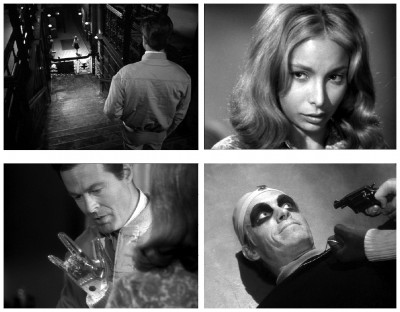 #37 DEMON WITH A GLASS HAND directed by Byron Haskin from a script by Harlan Ellison. Ten days ago Trent (Robert Culp) woke up with no memory of his past. His left hand has been replaced by an advanced hand-shaped computer protected by transparent material, but three fingers are missing. The computer tells him they must be reattached before it can tell Trent what is going on. Trent is being hunted by a group of humanoid aliens called the Kyben who have his missing fingers. The action takes place in a large rundown office building which the Kyben have sealed off from the rest of the world. In this deadly game of hide-and-seek, Trent enlists the help of Consuelo (Arlene Martei), a woman who works in the building. They capture a Kyben who tells Trent that he and they are from a thousand years in the future, sent into the past via a time-mirror located within the building. In that future, Earth has been conquered by the Kyben, who are now dying off due to a plague unleashed by the human race as a last-ditch effort to repel the alien invasion. In a desperate attempt to find a cure for the plague and to extract the information stored in his hand-shaped computer, the Kyben have followed Trent back in time with the missing fingers. Trent eventually defeats all the Kyben hunters by removing their medallions which anchor them to the past, destroys the time-mirror and recovers his missing fingers. When the computer is whole, he learns the terrible truth: he is not human, but a robot sent into the past by humans, who have digitally encoded themselves onto a gold-copper alloy wire wrapped around the solenoid in his thorax. Immune to disease, he must protect his precious cargo for the next twelve hundred years, by which time the Kybens and the plague will have passed, and he can then resurrect the human race.
#37 DEMON WITH A GLASS HAND directed by Byron Haskin from a script by Harlan Ellison. Ten days ago Trent (Robert Culp) woke up with no memory of his past. His left hand has been replaced by an advanced hand-shaped computer protected by transparent material, but three fingers are missing. The computer tells him they must be reattached before it can tell Trent what is going on. Trent is being hunted by a group of humanoid aliens called the Kyben who have his missing fingers. The action takes place in a large rundown office building which the Kyben have sealed off from the rest of the world. In this deadly game of hide-and-seek, Trent enlists the help of Consuelo (Arlene Martei), a woman who works in the building. They capture a Kyben who tells Trent that he and they are from a thousand years in the future, sent into the past via a time-mirror located within the building. In that future, Earth has been conquered by the Kyben, who are now dying off due to a plague unleashed by the human race as a last-ditch effort to repel the alien invasion. In a desperate attempt to find a cure for the plague and to extract the information stored in his hand-shaped computer, the Kyben have followed Trent back in time with the missing fingers. Trent eventually defeats all the Kyben hunters by removing their medallions which anchor them to the past, destroys the time-mirror and recovers his missing fingers. When the computer is whole, he learns the terrible truth: he is not human, but a robot sent into the past by humans, who have digitally encoded themselves onto a gold-copper alloy wire wrapped around the solenoid in his thorax. Immune to disease, he must protect his precious cargo for the next twelve hundred years, by which time the Kybens and the plague will have passed, and he can then resurrect the human race.
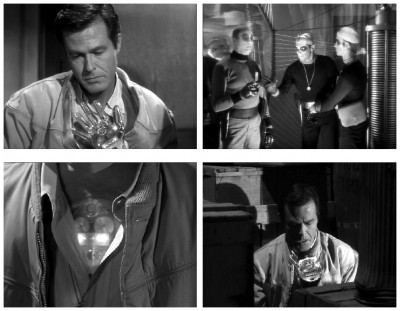 As originally written by Harlan Ellison, the script depicted a sprawling cross-country chase but, because this would have been too expensive to film, producer Robert Justman suggested that Ellison rewrite the episode, containing most of the action in a single structure. Ellison agreed, forcing the plot into an enclosed space, changing the linear pursuit to a vertical climb. Most of this episode was shot in the beloved Bradbury Building, as seen in D.O.A. (1950), The Indestructible Man (1956), Blade Runner (1982) and more recently in The Artist (2011). As many film fans already know, Ellison sued the makers of The Terminator (1984), insinuating that the film was directly inspired by both Demon With A Glass Hand and Soldier. Against James Cameron‘s wishes, Orion Pictures settled for an undisclosed amount and stuck-on the addition credit, ‘Based On The Works Of Harlan Ellison’ but, as both Ellison and Cameron are well-aware, The Terminator was actually inspired by the the low-budget film Cyborg 2087 (1966) starring Michael Rennie as a cyborg sent back in time to prevent future tyranny, chased by unstoppable robots called ‘Tracers’. Ellison wrote the script specifically with actor Robert Culp in mind, and much of the episode’s appeal can be attributed to Culp’s performance as the mysterious Trent. He exudes intelligence, humanity and not an ounce of hysteria, but rather a quiet desperation as he dodges attack after attack during his dangerous search for answers. Also fascinating in its own right is the glass hand, a glittering piece of art with printed circuitry exposed beneath its transparent skin, this is one of the most interesting props ever designed for a television show, and Culp himself supplies the voice of the hand-shaped computer.
As originally written by Harlan Ellison, the script depicted a sprawling cross-country chase but, because this would have been too expensive to film, producer Robert Justman suggested that Ellison rewrite the episode, containing most of the action in a single structure. Ellison agreed, forcing the plot into an enclosed space, changing the linear pursuit to a vertical climb. Most of this episode was shot in the beloved Bradbury Building, as seen in D.O.A. (1950), The Indestructible Man (1956), Blade Runner (1982) and more recently in The Artist (2011). As many film fans already know, Ellison sued the makers of The Terminator (1984), insinuating that the film was directly inspired by both Demon With A Glass Hand and Soldier. Against James Cameron‘s wishes, Orion Pictures settled for an undisclosed amount and stuck-on the addition credit, ‘Based On The Works Of Harlan Ellison’ but, as both Ellison and Cameron are well-aware, The Terminator was actually inspired by the the low-budget film Cyborg 2087 (1966) starring Michael Rennie as a cyborg sent back in time to prevent future tyranny, chased by unstoppable robots called ‘Tracers’. Ellison wrote the script specifically with actor Robert Culp in mind, and much of the episode’s appeal can be attributed to Culp’s performance as the mysterious Trent. He exudes intelligence, humanity and not an ounce of hysteria, but rather a quiet desperation as he dodges attack after attack during his dangerous search for answers. Also fascinating in its own right is the glass hand, a glittering piece of art with printed circuitry exposed beneath its transparent skin, this is one of the most interesting props ever designed for a television show, and Culp himself supplies the voice of the hand-shaped computer.
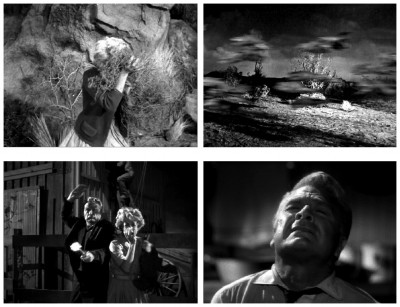 #38 CRY OF SILENCE directed by Charles Haas from a script by Robert C. Dennis and Louis Charbonneau. Andy Thorne (Eddie Albert) and his wife Karen (June Havoc) are city couple visiting the countryside who drive into a mysterious valley where their car hits a rock and abruptly stops working. After they leave their car, Karen accidentally sprains her ankle and, when Andy reaches her, they realise they’re being stalked by tumbleweeds possessed by some form of energy. At first they attempt to keep the tumbleweeds at bay with fire, but soon run out of fuel. They are saved by a severely disturbed farmer named Lamont (Arthur Hunnicutt), who explains that things have been awkward in the valley ever since a meteor hit two weeks before, causing his entire farm to die out. Lamont tells them the possessed flora and fauna won’t allow him to leave. The three make their way to Lamont’s house where they spend a frightening night surrounded by tumbleweeds and thousands of frogs. Next morning, they walk back to the car without trouble, but Lamont is killed when they are attacked by rocks, and Andy and Karen run back to the house. Lamont soon returns to the house as a zombie possessed by an unknown entity. Karen finds Lamont’s diary containing passages regarding his awareness of an apparent alien presence, and Andy decides the only way they can leave is by communicating with whatever is behind the possessions. Andy makes contact using self-hypnosis and is briefly possessed by a non-corporeal alien mind that came to Earth out of curiosity, but failed to establish communications. After communicating the theory that mankind perhaps needs more time to evolve, the extraterrestrial departs and everything returns to normal, allowing Andy and Karen to return to their car and leave. Cry Of Silence is probably the least-regarded of all The Outer Limits episodes. The ending is tiresome and unenlightening, and both Eddie Albert and June Havoc give uninspired performances, unable to do anything with such a poor script.
#38 CRY OF SILENCE directed by Charles Haas from a script by Robert C. Dennis and Louis Charbonneau. Andy Thorne (Eddie Albert) and his wife Karen (June Havoc) are city couple visiting the countryside who drive into a mysterious valley where their car hits a rock and abruptly stops working. After they leave their car, Karen accidentally sprains her ankle and, when Andy reaches her, they realise they’re being stalked by tumbleweeds possessed by some form of energy. At first they attempt to keep the tumbleweeds at bay with fire, but soon run out of fuel. They are saved by a severely disturbed farmer named Lamont (Arthur Hunnicutt), who explains that things have been awkward in the valley ever since a meteor hit two weeks before, causing his entire farm to die out. Lamont tells them the possessed flora and fauna won’t allow him to leave. The three make their way to Lamont’s house where they spend a frightening night surrounded by tumbleweeds and thousands of frogs. Next morning, they walk back to the car without trouble, but Lamont is killed when they are attacked by rocks, and Andy and Karen run back to the house. Lamont soon returns to the house as a zombie possessed by an unknown entity. Karen finds Lamont’s diary containing passages regarding his awareness of an apparent alien presence, and Andy decides the only way they can leave is by communicating with whatever is behind the possessions. Andy makes contact using self-hypnosis and is briefly possessed by a non-corporeal alien mind that came to Earth out of curiosity, but failed to establish communications. After communicating the theory that mankind perhaps needs more time to evolve, the extraterrestrial departs and everything returns to normal, allowing Andy and Karen to return to their car and leave. Cry Of Silence is probably the least-regarded of all The Outer Limits episodes. The ending is tiresome and unenlightening, and both Eddie Albert and June Havoc give uninspired performances, unable to do anything with such a poor script.
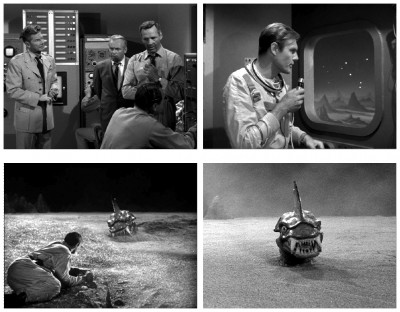 #39 THE INVISIBLE ENEMY directed by Byron Haskin from a script by Jerry Sohl and Seeleg Lester. Two astronauts land on Mars in the year 2021. One astronaut leaves to explore the landscape only to die screaming in unbearable agony, and the second astronaut goes out to investigate only to suffer the same fate. Six years later a second mission arrives with a crew of four, tasked to both explore the Martian landscape and to find out what happened to the first mission. When an engineer (Peter Marko) is sent to explore the ruins of the first mission, he walks around the ship and suddenly screams in terror, just as the previous crew did. The remaining astronauts are ordered to stay within the confines of their ship in the last hours before take-off, but the ship’s geologist (Rudy Solari) has a vision of Mars with sand-filled oceans, and leaves the ship to examine these ‘oceans’. On his way out he accidentally cuts his hand, rubs the blood onto a scrap of cloth and throws it out into the desert. Thus he learns that a sand-beast – a crustacean-like animal that swims through the sands like a shark – is responsible for the deaths. The captain of the expedition (Adam West) goes out to find the geologist and becomes trapped on a rock when the sand-beast pursues him. With ten minutes left until blast-off, the geologist creates a distraction by running across the sands, which allows both men to reach the shore unharmed and shoot the sand-beast with a nuclear bazooka. The fatally wounded sand-beast submerges but other sand-beasts appear, and the two remaining astronauts find themselves surrounded by an army of the creatures, their survival in jeopardy. Needless to say, the astronauts make it back to the ship alive and communicate to Earth that they’re on their way back home. The Outer Limits is one of the best television series to come out of America, but even its greatest fans would admit that sometimes the monsters or aliens in the show have not aged well. Admittedly, the monster in The Invisible Enemy is very cheesy indeed, but it could have been a good show nonetheless. The problem here is definitely the writing. Byron Haskin, along with the producer, the story editor and the writer, were not thrilled by this particular episode – in fact they hated it. The episode was based on a short story by Jerry Sohl first published in 1955 which takes place on a distant planet in another solar system. The warship ‘Nesbitt’ lands to investigate the disappearance of a number of spaceships sent to the planet. First, a ten-man expeditionary team is consumed from inside a force-field, followed by twenty-nine more men killed. A lone survivor named Lazzari is found in the desert but kills himself by smashing his head against a bulkhead, so the remaining crew gather outside the ship to give him a military burial. The computer expert Allison protests against the burial as blood seems to provoke the attacks, and is locked inside the ‘Nesbitt’ by the mission commander. Allison watches helplessly as the funeral party is eaten by large, heavy porpoise-like creatures swimming up out of the sand as if it were water.
#39 THE INVISIBLE ENEMY directed by Byron Haskin from a script by Jerry Sohl and Seeleg Lester. Two astronauts land on Mars in the year 2021. One astronaut leaves to explore the landscape only to die screaming in unbearable agony, and the second astronaut goes out to investigate only to suffer the same fate. Six years later a second mission arrives with a crew of four, tasked to both explore the Martian landscape and to find out what happened to the first mission. When an engineer (Peter Marko) is sent to explore the ruins of the first mission, he walks around the ship and suddenly screams in terror, just as the previous crew did. The remaining astronauts are ordered to stay within the confines of their ship in the last hours before take-off, but the ship’s geologist (Rudy Solari) has a vision of Mars with sand-filled oceans, and leaves the ship to examine these ‘oceans’. On his way out he accidentally cuts his hand, rubs the blood onto a scrap of cloth and throws it out into the desert. Thus he learns that a sand-beast – a crustacean-like animal that swims through the sands like a shark – is responsible for the deaths. The captain of the expedition (Adam West) goes out to find the geologist and becomes trapped on a rock when the sand-beast pursues him. With ten minutes left until blast-off, the geologist creates a distraction by running across the sands, which allows both men to reach the shore unharmed and shoot the sand-beast with a nuclear bazooka. The fatally wounded sand-beast submerges but other sand-beasts appear, and the two remaining astronauts find themselves surrounded by an army of the creatures, their survival in jeopardy. Needless to say, the astronauts make it back to the ship alive and communicate to Earth that they’re on their way back home. The Outer Limits is one of the best television series to come out of America, but even its greatest fans would admit that sometimes the monsters or aliens in the show have not aged well. Admittedly, the monster in The Invisible Enemy is very cheesy indeed, but it could have been a good show nonetheless. The problem here is definitely the writing. Byron Haskin, along with the producer, the story editor and the writer, were not thrilled by this particular episode – in fact they hated it. The episode was based on a short story by Jerry Sohl first published in 1955 which takes place on a distant planet in another solar system. The warship ‘Nesbitt’ lands to investigate the disappearance of a number of spaceships sent to the planet. First, a ten-man expeditionary team is consumed from inside a force-field, followed by twenty-nine more men killed. A lone survivor named Lazzari is found in the desert but kills himself by smashing his head against a bulkhead, so the remaining crew gather outside the ship to give him a military burial. The computer expert Allison protests against the burial as blood seems to provoke the attacks, and is locked inside the ‘Nesbitt’ by the mission commander. Allison watches helplessly as the funeral party is eaten by large, heavy porpoise-like creatures swimming up out of the sand as if it were water.
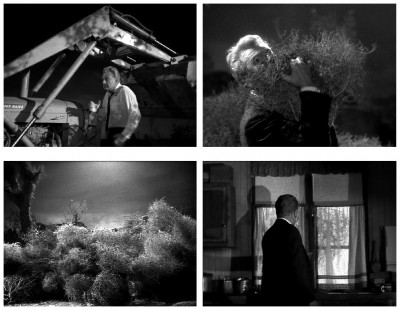 Thanks goes to Wikipedia for certain information, and a big thanks to David J. Schow and Jeffrey Frentzen, authors of the definitive tome The Outer Limits Official Companion (Ace SF 1986), one of the first best television episode guide books ever to be published. If you have any interest in the early formative days of American television, this volume should definitely be near the top of your list. And it’s with that thought in mind I bid you farewell, and please join me again next week as we see what the postman leaves on my doorstep – and sets on fire – in Horror News! Toodles!
Thanks goes to Wikipedia for certain information, and a big thanks to David J. Schow and Jeffrey Frentzen, authors of the definitive tome The Outer Limits Official Companion (Ace SF 1986), one of the first best television episode guide books ever to be published. If you have any interest in the early formative days of American television, this volume should definitely be near the top of your list. And it’s with that thought in mind I bid you farewell, and please join me again next week as we see what the postman leaves on my doorstep – and sets on fire – in Horror News! Toodles!
 Horror News | HNN Official Site | Horror Movies,Trailers, Reviews
Horror News | HNN Official Site | Horror Movies,Trailers, Reviews
